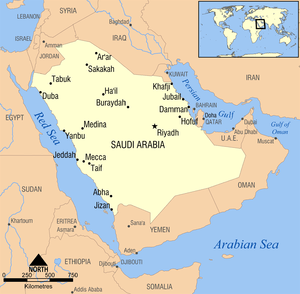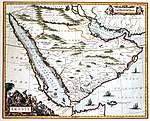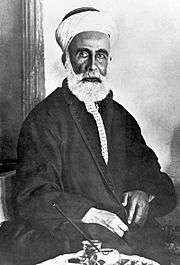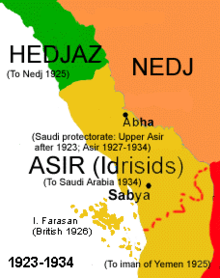Unification of Saudi Arabia
The Unification of Saudi Arabia was a military and political campaign in which the various tribes, sheikhdoms, city-states, emirates, and kingdoms of most of the Arabian Peninsula were conquered by the House of Saud, or Al Saud. Unification started in 1902 and continued until 1932, when the Kingdom of Saudi Arabia was proclaimed under the leadership of Ibn Saud, creating what is sometimes referred to as the Third Saudi State, to differentiate it from the Emirate of Diriyah, the First Saudi State and the Emirate of Nejd, the Second Saudi State, also House of Saud states.
| Unification of the Saudi-ruled Arabia | ||||||||
|---|---|---|---|---|---|---|---|---|
 Present Saudi state (Saudi Arabia) | ||||||||
| ||||||||
| Belligerents | ||||||||
|
Supported by: |
Supported by: |
Supported by: | ||||||
| Commanders and leaders | ||||||||
|
|
|
| ||||||
| Strength | ||||||||
| 38,000 | 77,000 | 23,000[9] | ||||||
| Casualties and losses | ||||||||
| Unknown | Unknown | |||||||
| 18,000+ killed in total[a][10] | ||||||||
Part of a series on the |
|---|
| History of Saudi Arabia |
 |
|
|
The Al-Saud had been in exile in the British-protected emirate of Kuwait since 1893 after their second episode of removal from power and dissolution of their polity, this time by the Al Rashid Emirate of Ha'il. In 1902, Ibn Saud recaptured Riyadh, the Al Saud dynasty's former capital. He went on to subdue the rest of Nejd, al-Hasa, Jebel Shammar, Asir, and Hejaz (the location of the Muslim holy cities of Mecca and Medina) between 1913 and 1926. The resultant polity was named the Kingdom of Nejd and Hejaz from 1927 until it was further consolidated with Al-Hasa into the Kingdom of Saudi Arabia in 1932.
Background


Following the Diriyah agreement between Muhammad ibn Abdul Wahhab and Muhammad ibn Saud, the Al Saud clan founded the First Saudi State, a state based on the strict defense of Islam. The ideology born of this period was later dubbed Wahhabism. Originating in the Nejd region of central Arabia, the First Saudi State conquered most of the Arabian Peninsula, culminating in the capture of the Muslim holy city of Mecca in 1802.[11]
The loss of Mecca was a significant blow to the prestige of the Ottoman Empire, which had exercised sovereignty over the holy city since 1517, and the Ottomans were finally moved to action against the Al Saud. The task of destroying the Saudis was given to the powerful viceroy of Egypt, Muhammad Ali Pasha, who sent troops to the Hejaz region and recaptured Mecca. His son, Ibrahim Pasha, meanwhile led Ottoman forces into the heart of Nejd, capturing town after town in the Nejd Expedition. On reaching the Saudi capital at Diriyah, Ibrahim placed it under siege for several months until it surrendered in the winter of 1818. He then sent many members of the clans of Al Saud and Ibn Abdul Wahhab to Egypt and the Ottoman capital of Constantinople and ordered the systematic destruction of Diriyah. The last Saudi imam (leader), Abdullah bin Saud, was later executed in Istanbul.[12]
The Al Saud survived in exile and went on to found the Second Saudi State, which is generally considered to have lasted from Turki ibn Abdallah's capture of Riyadh (which he designated as the new capital) in 1824 until the Battle of Mulayda in 1891. The Second Saudi period was marked by instability, which the Al Rashid clan of Jebel Shammar were able to exploit. The Saudi leader, Abdul Rahman ibn Faisal, sought refuge in Ottoman Iraq in 1893.[13]
History
Saudi take over of Riyadh
In 1901, Abdul Rahman's son, Abdulaziz bin Abdul Rahman Al Saud–later to be known as Ibn Saud–[14] asked the Emir of Kuwait for men and supplies for an attack on Riyadh. Already involved in several wars with the Rashidis, the Emir agreed to the request, giving Ibn Saud horses and arms. Although the exact number of men waxed and waned during the subsequent journey, he is believed to have left with around 40 men.[15]
In January 1902, Ibn Saud and his men reached Riyadh. With only a small force, he felt that the only way to take the city was to capture Masmak fort and kill Ibn Ajlan, Chief of Riyadh, and having achieved these goals they successfully took the city within the night. With the capture of his family's ancestral home, Ibn Saud proved he possessed the qualities necessary to be a sheikh or emir: leadership, courage, and luck.[16][17] This marked the beginning of the third Saudi state. Ibn Saud's dominions became known as the Emirate of Nejd and Hasa,[18] which lasted until 1921.[19]
Saudi–Rashidi War
The Saudi–Rashidi War, also referred as the "First Saudi–Rashidi War" or the "Battles for Qasim", was engaged between the Saudi loyal forces of the newborn Sultanate of Nejd versus the Emirate of Ha'il (Jabal Shammar), under the Rashidis. The warfare period of sporadic battles ended with Saudi takeover of the Al-Qassim Region, after decisive victory in Qasim on 13 April 1906,[20] though other engagements followed into 1907.
Al-Hasa and Qatif
In 1913, Ibn Saud, with support from the Ikhwan,[21] conquered al-Hasa from an Ottoman garrison, who had controlled the area from 1871.[22] He then integrated al-Hasa and Qatif into the Emirate.[23] The people in these areas were Shias and the Saudis Wahhabi puritans, resulting in harsh penalties for Shi'a Islam in Saudi Arabia, contrary to what the traditionally tolerant Sunni Ottomans allowed.[21]
Kuwait–Najd War
The Kuwait-Najd War occurred because Ibn Saud wanted to annex Kuwait.[24][25] Ibn Saud insisted that Kuwait's territory belonged to him.[25] The sharpened conflict between Kuwait and Najd led to the death of hundreds of Kuwaitis. The war resulted in sporadic border clashes throughout 1919–1920.[26]
Following Kuwait–Najd War, Ibn Saud imposed a tight trade blockade against Kuwait for 14 years from 1923 until 1937.[24][27] The goal of the Saudi economic and military attacks on Kuwait was to annex as much of Kuwait's territory as possible.[24] At the Uqair conference in 1922, the boundaries of Kuwait and Najd were set.[24] Kuwait had no representative at the Uqair conference.[24] Ibn Saud persuaded Sir Percy Cox to give him two-thirds of Kuwait's territory.[24] More than half of Kuwait was lost due to Uqair.[24] After the Uqair conference, Kuwait was still subjected to a Saudi economic blockade and intermittent Saudi raiding.[24]
During World War I
In December, the British government (started early 1915) attempted to cultivate favor with Ibn Saud via its secret agent, Captain William Shakespear, and this resulted in the Treaty of Darin. After Shakespear's death at the Battle of Jarrab, the British began supporting Ibn Saud's rival Sharif Hussein bin Ali, leader of the Hejaz. Lord Kitchener also appealed to Hussein bin Ali, Sharif of Mecca for assistance in the conflict and Hussein wanted political recognition in return. An exchange of letters with Henry McMahon assured him that his assistance would be rewarded between Egypt and Persia, with the exception of imperial possessions and interests in Kuwait, Aden, and the Syrian coast. Contrary to its negotiations with Ali, the British entered into the Treaty of Darin, which made the lands of the House of Saud a British protectorate. Ibn Saud pledged to again make war against Ibn Rashid, who was an ally of the Ottomans. Ibn Saud was also given a monthly stipend in exchange for waging war against Ibn Rashid.
First Nejd–Hejaz War
The First Saudi-Hashemite War or the Al-Khurma dispute took place in 1918–1919 between Abdulaziz Ibn Abdul Rahman AlSaud of the Emirate of Nejd and the Hashemites of the Kingdom of Hejaz. The war came within the scope of the historic conflict between the Hashemites of Hejaz and the Saudis of Riyadh (Nejd) over supremacy in Arabia.[28] It resulted in the defeat of the Hashemite forces and capture of al-Khurma by the Saudis and his allied Ikhwan, but British intervention prevented the immediate collapse of the Hashemite kingdom, establishing a sensitive cease-fire, which would last until 1924.
Conquest of Ha'il
Conquest of Ha'il, also referred as the Second Saudi–Rashidi War, was engaged by the Saudi forces with its ally Ikhwan tribesmen upon the Emirate of Ha'il (Jabal Shammar), under the last Rashidi rulers. On 2 November 1921, Jebel Shammar was completely conquered by Saudi forces and subsequently incorporated into the Sultanate of Nejd.
Ikhwan raids
Raids on Transjordan
Ikhwan raids on Transjordan were a series of plunders by the Ikhwan, irregular Arab tribesmen of Najd, on Transjordan between 1922 and 1924. Though the raids were not orchestrated by Ibn Saud, the ruler of Nejd, nothing was done by him to stop the raiding parties of his ally Ikhwanis. This however changed after the conquest of Hejaz, when the increasingly critical and negative stance of Ibn Saud on Ikhwan raids developed into an open feud and essentially a bloody conflict since 1927.
In early 1920s, the repeated Wahhabi incursions of Ikhwan from Najd into southern parts of his territory were the most serious threat to emir Abdullah's position in Transjordan.[29] The emir was powerless to repel those raids by himself, thus the British maintained a military base, with a small air force, at Marka, close to Amman.[29]
1921 raid on Iraq
In 1921, an Ikhwan party raided southern Iraq, pillaging Shia villages, resulting in the massacre of 700 Shias.[30]
Second Nejd–Hejaz War
The Saudi conquest of Hejaz was a campaign, engaged by Saudi Sultan Abdulaziz AlSaud to take over the Hashemite Kingdom of Hejaz in 1924–1925. The campaign successfully ended in December 1925, with the fall of Jeddah. Subsequently, in 1926, Ibn Saud was proclaimed king of Hejaz, and raised Nejd to a kingdom as well in 1927. For the next five-plus years, the Saudi domains were referred to as the Kingdom of Nejd and Hejaz, though they were administered as separate units.
Ikhwan rebellion

As Saudi expansion slowed in the 1920s, some among the Ikhwan pushed for continued expansion, particularly to the British-controlled territories such as Transjordan to the north - where the Ikhwan raided in 1922 and 1924. By this time, the few parts of central Arabia that hadn't been overrun by the Saudi-Ikhwan forces had treaties with Britain, and Abdul Aziz was sober enough to realize the folly of a potential conflict with the British. However, the Ikhwan had been taught that all non-Wahhabis were infidels. Faisal al-Dawish of the Mutair tribe and Sultan bin Bajad of the Otaiba tribe, the leaders of the Ikhwan, were among those who accused Abdul Aziz of going "soft", with the former reportedly telling the latter that the Saudis were "as much use as camel bags without handles".
A rebellion erupted, climaxing in a battle at Sabillah, which some have labeled a massacre but pro-Saudi sources consider to have been a fair fight.[31] Additional battles erupted through 1929 in Jabal Shammar and in the vicinity of the Awazim tribe. The rebellion was put down in 1930, with the surrender of last opposition elements. Though the survivors were jailed, their descendants remained opposed to Saudi rule, and one such descendant, Juhayman al-Otaibi, would gain infamy in 1979 when he led the Grand Mosque Seizure.[32][33]
Declaration of the Kingdom of Saudi Arabia
From 1927 to 1932, Ibn Saud administered the two main portions of his realm, Nejd and the Hejaz, as separate units. On 23 September 1932, Ibn Saud proclaimed the union of his dominions into the Kingdom of Saudi Arabia. Ibn Saud's eldest son Saud became crown prince in 1933.[34]
Aftermath
Annexation of Asir

The region of Asir, in what is today southern Saudi Arabia, had been under Turkish rule from 1871 until the outbreak of the First World War, at which point its emir, Hasan ibn Ali Al Aid, "became virtually independent" and attempted to rule from Abha. However, a struggle ensued between his forces and those of Muhammad ibn Ali al-Idrisi, who eventually set up the short-lived Idrisid Emirate under Saudi tutelage.[35] The emirate was subsumed by the Saudi state following a 1930 treaty which provided for the territory to come under Ibn Saud's direct control upon its emir's death.[34] The Emirate was eventually incorporated into the Kingdom of Saudi Arabia in 1934.
Saudi–Yemeni War
With the disintegration of the Ottoman Empire, a Zaidi state was forged in Yemen under Imam Muhammad bin Yahya Hamid ad-Din and his descendants. The Yemenis claimed parts of Asir and came to blows with the Saudis in 1933. Writing in the American journal Foreign Affairs in 1934, historian Hans Kohn noted, "Some European observers have wished to explain the armed conflict as a conflict between British and Italian policy in Arabia." Despite British ties to Saudi Arabia and Italian ties to Yemen, he concluded that "the rivalry between the two rulers is in no way caused or fostered by the rivalry of the two European states."[36] However, in 1998, Alexei Vassiliev wrote, "The imam was instigated both by the Italians, who promoted assistance in order to increase their influence in Yemen, and by the British, who wished to detract Imam Yahya's attention from their protectorates in Aden."[37] The Saudis struck back, reaching the Yemeni port of Al Hudaydah before signing a "treaty of Muslim friendship and Arab brotherhood" in Ta'if, which was published simultaneously in Mecca, Sanaa, Damascus, and Cairo to highlight its pan-Arabism.[38][39]
Remarking on the implications of the treaty, which stated "that [the two parties'] nations are one and agree to consider each other's interests their own", Kohn wrote, "The foreign policy of both kingdoms will be brought into line and harmonized so that both countries will act as one country in foreign affairs. Practically, it will mean a protectorate over the Yemen by Ibn Saud, the stronger and much more progressive partner."[39] Relations indeed remained close until civil war erupted in Yemen in the 1960s, at which time the country became a staging ground for battle between conservative values and those of the Egyptian revolutionary Gamal Abdel Nasser.[40]
Ikhwan movement
The exact circumstances under which the Ikhwan (brothers, brethren) arose remain unclear. However, it is known that they consisted of Bedouin who were imbued with Wahhabi zeal at settlements known as hijras. They played an important role in the Saudi rise to power, though the extent of that role is sometimes disputed.[41]
See also
- Geography of Saudi Arabia
- Saudi Arabia – United Arab Emirates border dispute
- Saudi–Kuwaiti neutral zone
- Saudi–Iraqi neutral zone
- Sykes–Picot Agreement
Footnotes
[a].^ Unification of Saudi Arabia (combined casualties figure estimation 7,989–8,989+) of:
- Battle of Riyadh (1902) – 37 killed.
- Battle of Dilam (1903) – 410 killed.
- Saudi–Rashidi War (1903–1907) – 2,300+ killed.
- Annexation of Al-Hasa and Qatif (1913) - unknown.
- Battle of Jarrab (1915)
- Battle of Kanzaan (1915)
- First Nejd-Hijaz War (1918-1919) – 1,392 killed.[10]
- 1921 Ikhwan raid on Iraq - 700 killed
- Kuwait–Nejd Border War (1921) – 200+ killed.[10]
- Conquest of Ha'il (1921) - unknown
- Ikhwan raids on Transjordan (1922–1924) – 500–1,500 killed.
- Saudi conquest of Hejaz (1924–1925) – 450+ killed.[10]
- Ikhwan Revolt (1927–1930) – 2,000 killed.[10]
Notes
- Chisholm, Hugh (25 March 2018). "The Encyclopedia Britannica: a dictionary of arts, sciences, literature and general information". The Encyclopedia Britannica Co.
- Peter W. Wilson, Douglas Graham. Saudi Arabia: the coming storm . M.E.Sharpe, 1994: p.45
- Leatherdale, Clive. Britain and Saudi Arabia, 1925-1939: the Imperial Oasis. p.115.
- https://raseef22.com/article/1071038-story-shammar-tribe-understand-indigenous-inhabitants-region
- Upbringing & Education 1902-1915 - The King Saud Foundation Website
- Al Kahtani, Mohammad Zaid (December 2004). "The Foreign Policy of King Abdulaziz" (PDF). University of Leeds. Retrieved 21 July 2013.
- Helmut Mejcher (May 2004). "King Faisal bin Abdulaziz Al Saud in the Arena of World Politics: A Glimpse from Washington, 1950 to 1971" (PDF). British Journal of Middle Eastern Studies. 31 (1): 5–23. doi:10.1080/1353019042000203412. Archived from the original (PDF) on 9 May 2013. Retrieved 15 April 2012.
- Sabri, Sharaf (2001). The House of Saud in commerce: A study of royal entrepreneurship in Saudi Arabia. New Delhi: I.S. Publications. ISBN 81-901254-0-0.
- David Murphy, (Illustrated by Peter Dennis), The Arab Revolt 1916-18: Lawrence Sets Arabia Ablaze, Osprey Publishing, 2008, p. 26.
- University of Central Arkansas, Middle East/North Africa/Persian Gulf Region
- Vassiliev 1998, pp. 83–103
- Vassiliev 1998, pp. 140–191
- Vassiliev 1998, pp. 198–204
- "Ibn" means "son" in Arabic and thus "Ibn Saud" means "Son of Saud" (see Arabic name). Although Westerners widely referred to Abdul Aziz as Ibn Saud in later years, "the clan chieftain's title of Ibn Sa'ud continued to refer to Abdul Rahman until he had established himself as such." (Lacey 1982, p. 65) Abdul Aziz never referred to himself by this title, and some authors (e.g. Helms 1981, p. 14), avoid using it entirely.
- Lacey observes, "Forty is the number which bedouin often pick upon when they wish to describe a smallish body of men, and forty is the number of companions which Abdul Aziz is said to have had with him when he left Kuwait in September 1901." (Lacey 1982, p. 41) Lacey offers further insight into the ambiguity surrounding the details of the capture of Riyadh, whose place in Saudi Arabian folklore he compares to the Storming of the Bastille: Ibn Saud himself told numerous versions over the years, which is only partly attributable to Ibn Saud's excitability. According to Lacey, "He was spinning history in the way that the Old Testament scribes spun their legends or the creator of the Chanson de Roland wove his epic, for even today it remains the pleasant obstinacy of the Arab to be less captivated by the distinction between fact and fiction than by mystery, romance, poetry, imagination – and even downright caprice." (Lacey 1982, p. 47)
- Troeller 1976, p. 21
- Vassiliev 1998, p. 213
- Madawi Al-Rasheed. A History of Saudi Arabia. Cambridge, England, UK: Cambridge University Press, 2002. Pp. 40.
- J. A. Hammerton. Peoples of All Nations: Their Life Today And Story of Their Past (in 14 Volumes). Concept Publishing Company, 2007. Pp. 193.
- Mikaberidze, Alexander (2011). Conflict and Conquest in the Islamic World: A Historical Encyclopedia. ABC-CLIO. p. 807. ISBN 978-1-59884-336-1.
- Jones, Toby (June 2009). Embattled in Arabia: Shias and the Politics of Confrontation in Saudi Arabia (PDF). Shia Militancy Program. Combating Terrorism Center at West Point / American Civil Liberties Union.
- Pp. 63, 124
- World and its peoples. London: Marshall Cavendish. 2006. p. 29. ISBN 0-7614-7571-0.
- Mary Ann Tétreault (1995). The Kuwait Petroleum Corporation and the Economics of the New World Order. pp. 2–3. ISBN 9780899305103.
- Michael S. Casey (2007). The History of Kuwait. pp. 54–55. ISBN 9781573567473.
- Illahi, Mahboob (2018). Doctrine of Terror: Saudi Salafi Religion. Victoria, Canada: Friesen Press. p. 117. ISBN 9781525526473.
- Mohammad Khalid A. Al-Jassar (2009). Constancy and Change in Contemporary Kuwait City: The Socio-cultural Dimensions of the Kuwait Courtyard and Diwaniyya. p. 80. ISBN 9781109229349.
- Mikaberidze, Alexander (31 July 2011). Conflict and Conquest in the Islamic World: A Historical Encyclopedia. ABC-CLIO. ISBN 9781598843361.
- Salibi, Kamal S. The modern history of Jordan. p. 104
- Moon, Farzana (2015). No Islam but Islam. Newcastle upon Tyne, UK: Cambridge Scholars Publishing. p. 142. ISBN 978-1443871181.
- Lacey 2009, pp. 14–16
- The origins of this event with the Ikhwan dissenters are described in multiple sources, though Lacey 2009 contains one of the most up-to-date accounts. For more information on the Grand Mosque Seizure itself, see The Siege of Mecca by Yaroslav Trofimov.
- Hegghamer and Lacroix, Thomas and Stéphane (Spring 2007). "Rejectionist Islamism in Saudi Arabia: The Story of Juhayman al-Utaybi Revisited". International Journal of Middle East Studies. 39: 1. doi:10.1017/S0020743807002553 – via JSTOR.
- Vassiliev 1998, pp. 283–285
- Vassiliev 1998, pp. 259–260
- Kohn 1934, p. 101
- Vassiliev 1998, p. 285
- Vassiliev 1998, pp. 285–286
- Kohn 1934, p. 102
- Vassiliev 1998, pp. 362–366
- Commins 2006, pp. 80–94
References
- Almana, Mohammed (1982). Arabia Unified: A Portrait of Ibn Saud. London: Hutchinson Benham. ISBN 0-09-147290-3.CS1 maint: ref=harv (link)
- Commins, David (2006). The Wahhabi Mission and Saudi Arabia. London, New York: I.B. Tauris. ISBN 978-1-84511-080-2.CS1 maint: ref=harv (link)
- Helms, Christine Moss (1981). The Cohesion of Saudi Arabia. Baltimore: The Johns Hopkins University Press.CS1 maint: ref=harv (link)
- Kohn, Hans (October 1934). "The Unification of Arabia". Foreign Affairs. 13 (1): 91–103. doi:10.2307/20030644. JSTOR 20030644.CS1 maint: ref=harv (link)
- Lacey, Robert (2009). Inside the Kingdom: Kings, Clerics, Modernists, Terrorists, and the Struggle for Saudi Arabia. New York: Viking. ISBN 978-0-670-02118-5.CS1 maint: ref=harv (link)
- Lacey, Robert (1982). The Kingdom. New York: Harcourt Brace Jovanovich. ISBN 0-15-147260-2.CS1 maint: ref=harv (link)
- Al-Rasheed, Madawi (2010). A History of Saudi Arabia (2nd ed.). New York: Cambridge University Press. ISBN 978-0-521-74754-7.CS1 maint: ref=harv (link)
- Troeller, Gary (1976). The Birth of Saudi Arabia: Britain and the Rise of the House of Sa'ud. London: Routledge. ISBN 0-7146-3062-4.CS1 maint: ref=harv (link)
- Vassiliev, Alexei (1998). The History of Saudi Arabia. London: Saqi. ISBN 0-86356-935-8.CS1 maint: ref=harv (link)
External links
| Wikimedia Commons has media related to Atlas of Saudi Arabia. |
- Hous of Saud, a 2005 documentary by PBS' Frontline. Website includes interviews and an excerpt containing the chapter on the Ikhwan.
